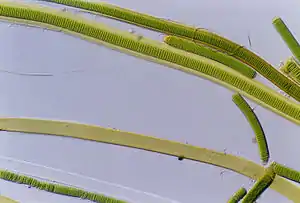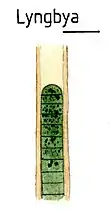Lyngbya
Lyngbya ist eine Gattung fädiger Cyanobakterien oder „Blaualgen“. Typspezies der Gattung ist Lyngbya confervoides C. Agardh[1]. Benannt ist die Gattung nach Hans Christian Lyngbye.
| Lyngbya | ||||||||||||
|---|---|---|---|---|---|---|---|---|---|---|---|---|

Lyngbya | ||||||||||||
| Systematik | ||||||||||||
| ||||||||||||
| Wissenschaftlicher Name | ||||||||||||
| Lyngbya | ||||||||||||
| Agardh Ex Gomont, 1892 |

Illustration (Detail)
Merkmale
Lyngbya wächst, wie für die Oscillatoriales typisch, in langen, unverzweigten Zellfäden, auch Filamente genannt. Diese sind von einer, oft farblosen, Gallerthülle umgeben[2]. Die Filamente können Matten bilden. Die Einzelzellen sind länger als breit. Zur Vermehrung werden Hormogonien (zur Kriechbewegung fähige Fadenfragmente) gebildet.
Toxine
Lyngbya zählt zu den giftigsten Gattungen der Cyanobacteria. Sie bilden zytotoxische Verbindungen wie Antillatoxin, Aplysiatoxin, Debromoaplysiatoxin und Lyngbyatoxin A, B und C.[3]
Arten (Auswahl)
_BHL11346758-9.jpg.webp)
L. aestuarii,
rechts Filament mit Hormogonien (ho).
Illustration von 1910.
rechts Filament mit Hormogonien (ho).
Illustration von 1910.
- Lyngbya aeruginea
- Lyngbya aestuarii
- Lyngbya confervoides
- Lyngbya contorta
- Lyngbya kuetzingii
- Lyngbya majuscula
Einzelnachweise
- https://www.algaebase.org/search/genus/detail/?genus_id=42975&sk=0
- D. M. John, Brian A. Whitton, Alan J. Brook: The freshwater algal flora of the British Isles: an identification guide to freshwater and terrestrial algae, Band 1. Cambridge University Press (England) 2002.
- Singh, Sawraj; Kate, Bhushan N; Banerjee, U C.: Bioactive Compounds from Cyanobacteria and Microalgae: An Overview In: Critical Reviews in Biotechnology Band 25, Ausgabe 3, S. 73–95 doi:10.1080/07388550500248498
Weblinks
Commons: Lyngbya – Sammlung von Bildern, Videos und Audiodateien
This article is issued from Wikipedia. The text is licensed under Creative Commons - Attribution - Sharealike. The authors of the article are listed here. Additional terms may apply for the media files, click on images to show image meta data.